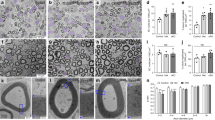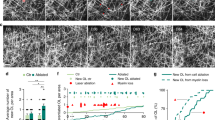Abstract
Axonal degeneration is important during development but has not been thought to function in the intact mature nervous system. Here, we provide evidence that degeneration of adult axons occurs in the intact rodent brain through a p75 neurotrophin receptor (p75NTR)- and myelin-dependent mechanism. Specifically, we show that p75NTR-mediated axonal degeneration prevents septal cholinergic axons from aberrantly growing onto myelinated tracts in vivo or on a myelin substrate in culture. Myelin also triggers local degeneration of p75NTR-expressing sympathetic axons that is rescued by increasing TrkA signaling or elevating intracellular cyclic AMP. Myelin-mediated degeneration occurs when neurotrophins bind to p75NTR, and involves p75NTR-dependent sequestration of Rho guanine nucleotide dissociation inhibitor (Rho-GDI). Moreover, degeneration, but not growth inhibition, requires downstream activation of Rho and caspase-6. These data indicate that p75NTR maintains the specificity of neural connectivity by preventing inappropriate sprouting onto myelinated tracts and provide a physiological explanation for myelin inhibition after neural injury.
This is a preview of subscription content, access via your institution
Access options
Subscribe to this journal
Receive 12 print issues and online access
$209.00 per year
only $17.42 per issue
Buy this article
- Purchase on Springer Link
- Instant access to full article PDF
Prices may be subject to local taxes which are calculated during checkout






Similar content being viewed by others
References
Singh, K.K. et al. Developmental axon pruning mediated by BDNF-p75NTR-dependent axon degeneration. Nat. Neurosci. 11, 649–658 (2008).
Luo, L. & O'Leary, D.D. Axon retraction and degeneration in development and disease. Annu. Rev. Neurosci. 28, 127–156 (2005).
Lyon, M.F., Ogunkolade, B.W., Brown, M.C., Atherton, D.J. & Perry, V.H. A gene affecting Wallerian nerve degeneration maps distally on mouse chromosome 4. Proc. Natl. Acad. Sci. USA 90, 9717–9720 (1993).
Mack, T.G. et al. Wallerian degeneration of injured axons and synapses is delayed by a Ube4b/Nmnat chimeric gene. Nat. Neurosci. 4, 1199–1206 (2001).
Nikolaev, A., McLaughlin, T., O'Leary, D.D. & Tessier-Lavigne, M. APP binds DR6 to trigger axon pruning and neuron death via distinct caspases. Nature 457, 981–989 (2009).
Singh, K.K. & Miller, F.D. Activity regulates positive and negative neurotrophin-derived signals to determine axon competition. Neuron 45, 837–845 (2005).
Cao, L. et al. Genetic modulation of BDNF signaling affects the outcome of axonal competition in vivo. Curr. Biol. 17, 911–921 (2007).
Plachta, N. et al. Identification of a lectin causing the degeneration of neuronal processes using engineered embryonic stem cells. Nat. Neurosci. 10, 712–719 (2007).
Yiu, G. & He, Z. Glial inhibition of CNS axon regeneration. Nat. Rev. Neurosci. 7, 617–627 (2006).
Filbin, M.T. Myelin-associated inhibitors of axonal regeneration in the adult mammalian CNS. Nat. Rev. Neurosci. 4, 703–713 (2003).
Atwal, J.K. et al. PirB is a functional receptor for myelin inhibitors of axonal regeneration. Science 322, 967–970 (2008).
Wong, S.T. et al. A p75(NTR) and Nogo receptor complex mediates repulsive signaling by myelin-associated glycoprotein. Nat. Neurosci. 5, 1302–1308 (2002).
Cai, D., Shen, Y., De Bellard, M., Tang, S. & Filbin, M.T. Prior exposure to neurotrophins blocks inhibition of axonal regeneration by MAG and myelin via a cAMP-dependent mechanism. Neuron 22, 89–101 (1999).
Woolf, N.J. Cholinergic systems in mammalian brain and spinal cord. Prog. Neurobiol. 37, 475–524 (1991).
Lee, K.F., Bachman, K., Landis, S. & Jaenisch, R. Dependence on p75 for innervation of some sympathetic targets. Science 263, 1447–1449 (1994).
Schnitzler, A.C., Lopez-Coviella, I. & Blusztajn, J.K. Purification and culture of nerve growth factor receptor (p75)-expressing basal forebrain cholinergic neurons. Nat. Protoc. 3, 34–40 (2008).
Castren, E., Thoenen, H. & Lindholm, D. Brain-derived neurotrophic factor messenger RNA is expressed in the septum, hypothalamus and in adrenergic brain stem nuclei of adult rat brain and is increased by osmotic stimulation in the paraventricular nucleus. Neuroscience 64, 71–80 (1995).
Kohn, J., Aloyz, R.S., Toma, J.G., Haak-Frendscho, M. & Miller, F.D. Functionally antagonistic interactions between the TrkA and p75 neurotrophin receptors regulate sympathetic neuron growth and target innervation. J. Neurosci. 19, 5393–5408 (1999).
Crutcher, K.A. Tissue sections from the mature rat brain and spinal cord as substrates for neurite outgrowth in vitro: extensive growth on gray matter but little growth on white matter. Exp. Neurol. 104, 39–54 (1989).
Savio, T. & Schwab, M.E. Rat CNS white matter, but not gray matter, is nonpermissive for neuronal cell adhesion and fiber outgrowth. J. Neurosci. 9, 1126–1133 (1989).
Belliveau, D.J. et al. NGF and neurotrophin-3 both activate TrkA on sympathetic neurons but differentially regulate survival and neuritogenesis. J. Cell Biol. 136, 375–388 (1997).
Hibbert, A.P., Kramer, B.M., Miller, F.D. & Kaplan, D.R. The localization, trafficking and retrograde transport of BDNF bound to p75NTR in sympathetic neurons. Mol. Cell. Neurosci. 32, 387–402 (2006).
Ma, Y., Campenot, R.B. & Miller, F.D. Concentration-dependent regulation of neuronal gene expression by nerve growth factor. J. Cell Biol. 117, 135–141 (1992).
Campenot, R.B., Lund, K. & Mok, S.A. Production of compartmented cultures of rat sympathetic neurons. Nat. Protoc. 4, 1869–1887 (2009).
Causing, C.G. et al. Synaptic innervation density is regulated by neuron-derived BDNF. Neuron 18, 257–267 (1997).
Yamashita, T. & Tohyama, M. The p75 receptor acts as a displacement factor that releases Rho from Rho-GDI. Nat. Neurosci. 6, 461–467 (2003).
Aktories, K., Braun, U., Rosener, S., Just, I. & Hall, A. The rho gene product expressed in E. coli is a substrate of botulinum ADP-ribosyltransferase C3. Biochem. Biophys. Res. Commun. 158, 209–213 (1989).
Roux, P.P., Colicos, M.A., Barker, P.A. & Kennedy, T.E. p75 neurotrophin receptor expression is induced in apoptotic neurons after seizure. J. Neurosci. 19, 6887–6896 (1999).
Kokaia, Z., Andsberg, G., Martinez-Serrano, A. & Lindvall, O. Focal cerebral ischemia in rats induces expression of P75 neurotrophin receptor in resistant striatal cholinergic neurons. Neuroscience 84, 1113–1125 (1998).
Bamji, S.X. et al. The p75 neurotrophin receptor mediates neuronal apoptosis and is essential for naturally occurring sympathetic neuron death. J. Cell Biol. 140, 911–923 (1998).
Majdan, M., Walsh, G.S., Aloyz, R. & Miller, F.D. TrkA mediates developmental sympathetic neuron survival in vivo by silencing an ongoing p75NTR-mediated death signal. J. Cell Biol. 155, 1275–1285 (2001).
Deppmann, C.D. et al. A model for neuronal competition during development. Science 320, 369–373 (2008).
Yeo, T.T. et al. Absence of p75NTR causes increased basal forebrain cholinergic neuron size, choline acetyltransferase activity, and target innervation. J. Neurosci. 17, 7594–7605 (1997).
Schwab, M.E. & Schnell, L. Channeling of developing rat corticospinal tract axons by myelin-associated neurite growth inhibitors. J. Neurosci. 11, 709–721 (1991).
Walsh, G.S., Krol, K.M., Crutcher, K.A. & Kawaja, M.D. Enhanced neurotrophin-induced axon growth in myelinated portions of the CNS in mice lacking the p75 neurotrophin receptor. J. Neurosci. 19, 4155–4168 (1999).
Marinissen, M.J. et al. The small GTP-binding protein RhoA regulates c-jun by a ROCK-JNK signaling axis. Mol. Cell 14, 29–41 (2004).
Park, Y.J. et al. The RhoGDI-alpha/JNK signaling pathway plays a significant role in mycophenolic acid-induced apoptosis in an insulin-secreting cell line. Cell. Signal. 21, 356–364 (2009).
Aloyz, R.S. et al. p53 is essential for developmental neuron death as regulated by the TrkA and p75 neurotrophin receptors. J. Cell Biol. 143, 1691–1703 (1998).
Salehi, A.H., Xanthoudakis, S. & Barker, P.A. NRAGE, a p75 neurotrophin receptor-interacting protein, induces caspase activation and cell death through a JNK-dependent mitochondrial pathway. J. Biol. Chem. 277, 48043–48050 (2002).
Kanamoto, T. et al. Role of apoptosis signal-regulating kinase in regulation of the c-Jun N-terminal kinase pathway and apoptosis in sympathetic neurons. Mol. Cell. Biol. 20, 196–204 (2000).
Kim, A.H. et al. Akt1 regulates a JNK scaffold during excitotoxic apoptosis. Neuron 35, 697–709 (2002).
Atwal, J.K., Massie, B., Miller, F.D. & Kaplan, D.R. The TrkB-Shc site signals neuronal survival and local axon growth via MEK and P13-kinase. Neuron 27, 265–277 (2000).
Lowry, K.S. et al. A potential role for the p75 low-affinity neurotrophin receptor in spinal motor neuron degeneration in murine and human amyotrophic lateral sclerosis. Amyotroph. Lateral Scler. Other Motor Neuron Disord. 2, 127–134 (2001).
Naumann, T. et al. Complete deletion of the neurotrophin receptor p75NTR leads to long-lasting increases in the number of basal forebrain cholinergic neurons. J. Neurosci. 22, 2409–2418 (2002).
Aubert, I., Ridet, J.L., Schachner, M., Rougon, G. & Gage, F.H. Expression of L1 and PSA during sprouting and regeneration in the adult hippocampal formation. J. Comp. Neurol. 399, 1–19 (1998).
Schwab, M.E. & Caroni, P. Oligodendrocytes and CNS myelin are nonpermissive substrates for neurite growth and fibroblast spreading in vitro. J. Neurosci. 8, 2381–2393 (1988).
Vaillant, A.R. et al. Depolarization and neurotrophins converge on the phosphatidylinositol 3-kinase-Akt pathway to synergistically regulate neuronal survival. J. Cell Biol. 146, 955–966 (1999).
Atwal, J.K., Singh, K.K., Tessier-Lavigne, M., Miller, F.D. & Kaplan, D.R. Semaphorin 3F antagonizes neurotrophin-induced phosphatidylinositol 3-kinase and mitogen-activated protein kinase kinase signaling: a mechanism for growth cone collapse. J. Neurosci. 23, 7602–7609 (2003).
Campenot, R.B., Walji, A.H. & Draker, D.D. Effects of sphingosine, staurosporine, and phorbol ester on neurites of rat sympathetic neurons growing in compartmented cultures. J. Neurosci. 11, 1126–1139 (1991).
Zhai, Q. et al. Involvement of the ubiquitin-proteasome system in the early stages of wallerian degeneration. Neuron 39, 217–225 (2003).
Acknowledgements
We thank J. Laver for helping with the time-course degeneration experiments, members of the Miller/Kaplan laboratory, J. Atwal, K. Coultes, L. Weng and J. Jordao for advice and technical assistance and P. Barker (McGill University) for p75NTR adenovirus. This work was supported by a grant from the Canadian Institutes of Health Research to F.D.M. and D.R.K. F.D.M. and D.R.K. are supported by the Canada Research Chairs program and F.D.M. by the Howard Hughes Medical Institute. K.J.P. was supported by an Ontario Graduate Scholarship.
Author information
Authors and Affiliations
Contributions
K.J.P. carried out all experiments and co-wrote the paper. C.A.G. participated in the in vivo analysis. I.A. supervised the septal cholinergic experiments. D.R.K. and F.D.M. co-supervised all experiments and co-wrote the paper.
Corresponding authors
Ethics declarations
Competing interests
The authors declare no competing financial interests.
Rights and permissions
About this article
Cite this article
Park, K., Grosso, C., Aubert, I. et al. p75NTR-dependent, myelin-mediated axonal degeneration regulates neural connectivity in the adult brain. Nat Neurosci 13, 559–566 (2010). https://doi.org/10.1038/nn.2513
Received:
Accepted:
Published:
Issue Date:
DOI: https://doi.org/10.1038/nn.2513
This article is cited by
-
RhoGDI phosphorylation by PKC promotes its interaction with death receptor p75NTR to gate axon growth and neuron survival
EMBO Reports (2024)
-
Combination of Electroacupuncture and Constraint-Induced Movement Therapy Enhances Functional Recovery After Ischemic Stroke in Rats
Journal of Molecular Neuroscience (2021)
-
Constitutive ablation of caspase-6 reduces the inflammatory response and behavioural changes caused by peripheral pro-inflammatory stimuli
Cell Death Discovery (2018)
-
p75NTR and TROY: Uncharted Roles of Nogo Receptor Complex in Experimental Autoimmune Encephalomyelitis
Molecular Neurobiology (2018)
-
Caspase vinyl sulfone small molecule inhibitors prevent axonal degeneration in human neurons and reverse cognitive impairment in Caspase-6-overexpressing mice
Molecular Neurodegeneration (2017)



